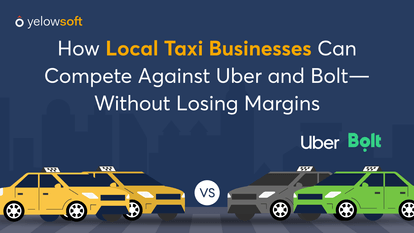The future of taxi dispatch is being rewritten by artificial intelligence.
What once depended on human judgment and manual processes is now driven by algorithms.
These algorithms can allocate rides in seconds, predict demand, and optimize every trip.
The change is happening fast, and by 2030, AI in the transportation market is expected to reach USD 10.3 billion at a growing CAGR of 15.8% (MarketsandMarkets).
As one expert puts it, “AI will not replace taxi dispatchers, but taxi dispatchers using AI will replace those who don’t.”
From smarter taxi dispatch software to safer, faster, and more profitable operations, AI is shaping a new standard for the AI in taxi industry.
In this blog, you will discover who is driving this change, the technologies behind it, and how you can prepare to thrive in the next era of taxi dispatch.
Who Will Shape the Future of Taxi Dispatch?
The future of taxi dispatch in the age of AI won’t be shaped by just one player.
It will be a joint effort between three key forces working together. The three forces are:
1. Technology Providers
AI-driven software companies will continue to advance smarter algorithms for automated dispatch, predictive demand analysis, and real time fleet tracking.
These innovations will enable taxi operators like you to cut down operational cost and manual redundancy in the coming time.
2. Taxi and Mobility Operators
Fleet owners, corporate transport services, and ride hailing startups will drive adoption by bringing AI tools into daily operations.
This integration will deliver faster response times, better customer experiences, and added safety through the SOS feature in taxi software and the SOS feature for taxi services.
3. Regulators and City Authorities
Governments and transport boards will set the guardrails for how AI is used in dispatch systems.
Their role will be to ensure innovation moves forward while keeping passenger safety, data privacy, and fair competition front and centre.
Together, these groups will determine how quickly AI in the taxi sector evolves and how far it can go in reshaping mobility for operators and passengers worldwide.
What is AI-Powered Taxi Dispatch?
AI taxi dispatch software is an intelligent system that applies artificial intelligence to manage and optimize taxi operations.
It automates trip assignments, predicts demand patterns, and enhances decision-making beyond the capabilities of traditional dispatch methods.
Defining AI Taxi Dispatch
AI taxi dispatch uses advanced algorithms to allocate rides efficiently, forecast demand spikes, and adjust pricing dynamically.
By analyzing real-time and historical data, it ensures optimal resource use, faster response times, and better profitability compared to conventional dispatch systems.
How does it differ from a traditional GPS-based dispatch system?
To know the real difference between the two systems, let’s have a look at the table below.
| Feature | AI Taxi Dispatch Software | Traditional GPS-Based Dispatch |
|---|---|---|
| Ride Allocation | Uses AI algorithms to match rides considering location, traffic, and driver performance | Assigns rides mainly based on driver location |
| Forecasting | Predicts demand and adjusts dispatch accordingly | No predictive capabilities |
| Pricing | Supports dynamic pricing based on demand and conditions | Fixed or manually set fares |
| Optimization | Proactively balances supply and demand for efficiency | Basic trip assignment without deep optimization |
What Will Change in Taxi Dispatch With AI?
The introduction of AI in taxi software is set to transform how ride-hailing and taxi businesses operate.
From smarter route planning to automated decision-making, AI-enabled systems will not just make dispatch faster, but also more profitable, reliable, and secure.
Below are the key AI-enabled dispatch changes that will redefine the industry.
Predictive Demand Forecasting
AI in taxi software can analyze historical trips, weather, local events, and time patterns to forecast demand.
A large-scale study on predictive dispatching in ride-sharing systems found that passenger waiting times dropped by 30%, and by up to 55% in high-demand areas. (Source).
Autonomous Dispatch Operations
AI can handle the entire ride assignment process automatically. This reduces errors and speeds up the allocation of trips.
Plus, these systems can also work with self-driving vehicles, preparing fleets for the future.
Dynamic Pricing Optimization
AI dynamic pricing in the taxi industry uses demand, supply, and competitor rates to adjust fares in real time. This maximized revenue while keeping pricing fair for customers.
AI-Powered Fraud Detection & Safety
Advanced AI models detect fake bookings, block suspicious activity, and trigger driver safety alerts instantly. This strengthens security for both passengers and drivers.
What Tools and Technologies Will Drive the Future of Taxi Dispatch?
AI-based taxi software tools are set to redefine how operators manage fleets, drivers, and passengers.
From backend automation to real-time engagement, these innovations make operations faster, smarter, and more connected.
AI Integration With Current Taxi Dispatch Software
With API and plugin models, operators like you can add AI features to their existing taxi dispatch platforms without replacing the whole system.
This makes it easier to move toward data-driven, intelligent operations while keeping the familiar setup.
AI + IoT for Smarter Fleet Management
Using IoT sensors, vehicles can share live updates on location, traffic, and health status.
These insights help AI taxi dispatch software make better ride allocation decisions, reduce downtime, and improve service speed.
AI in Customer Communication
AI customer engagement in taxi apps comes to life through chatbots, automated notifications, and in-app translations.
These tools provide instant answers, smooth booking flows, and a more personalized passenger experience.
What Challenges Will Taxi Operators Face?
Adopting AI is exciting, but challenges in AI taxi dispatch can slow down its full potential. Let’s look at the key hurdles operators must navigate before seeing results.
High Implementation Costs
AI-driven dispatch systems demand a significant initial investment in software, integrations, and infrastructure. Smaller operators may struggle with these costs, making careful ROI planning essential.
Data Privacy and Bias
If AI algorithms are trained on incomplete or biased data, ride allocation can become unfair, leading to service imbalances and dissatisfied customers. Compliance with data privacy regulations is also critical to avoid penalties.
Workforce Adaptation
Even the most advanced AI tools require human collaboration. Dispatchers and drivers need training to use the system effectively, which can be time-consuming and resource-intensive.
While the potential of AI dispatch is undeniable, success depends on overcoming these early hurdles. With the right strategy, operators can move past these challenges and unlock the real benefits of smarter, faster, and fairer ride allocation.
Why AI is the Inevitable Future of Taxi Dispatch
The future of AI taxi dispatch is here, and it is reshaping how operators manage fleets, serve passengers, and stay ahead of competitors.
By combining automated dispatch with intelligent algorithms, taxi companies can match drivers to ride in seconds, reduce idle time, and maximize earnings.
Operational Efficiency Gains
AI-powered systems integrate real time fleet tracking to monitor every vehicle’s location and status. This allows dispatchers to allocate trips based on proximity, traffic conditions, and driver availability, slashing wait times and improving vehicle utilization.
Better Passenger Experience
With advanced AI tools, passengers get ultra-accurate ETAs, seamless booking flows, and personalized ride offers. The SOS feature in taxi software ensures passenger safety by enabling instant alerts to the control center in emergencies, building trust and loyalty.
Competitive Advantage
In the future of AI taxi dispatch, early adopters will dominate their market. Operators that leverage automated dispatch and safety tools like the SOS feature for taxi can deliver faster, smarter, and more reliable services than their rivals, setting a new industry benchmark.
How Taxi Companies Can Transition to AI-Powered Dispatch Today
Embracing AI adoption in taxi business is no longer a futuristic move—it’s a competitive necessity.
The good news is that making the shift to AI-powered dispatch can be smooth and structured. Below are three practical steps to get started.
1. Audit Your Current Dispatch System
Begin by mapping out how your current system handles bookings, allocations, and driver tracking. Identify delays, missed rides, or manual tasks that AI could automate. This step creates a clear blueprint for improvement.
2. Choose the Right AI Partner
Partner with a technology provider who understands both mobility solutions and the operational needs of taxi companies.
Solutions like Yelowsoft offer tailored AI-driven features designed to boost efficiency without disrupting your existing workflows.
3. Run a Pilot Program
Instead of jumping into a full deployment, launch a pilot program in a limited area or fleet segment.
This allows you to monitor performance, gather driver feedback, and fine-tune AI settings before scaling across your entire operation.
By following these steps, taxi operators can confidently embrace AI adoption in taxi business, ensuring a seamless transition that drives faster allocations, better resource use, and higher customer satisfaction.
Conclusion
The future of taxi operations is all about being smarter, faster, and more efficient. And AI adoption in taxi business is the key to making that happen.
Moving away from old manual methods or basic GPS dispatch opens the door to real-time decisions, smarter routes, and better use of resources.
Yes, the change might feel big, but with the right strategy and the right technology partner, the shift can be smooth and stress-free.
Companies that start using AI now will be able to serve customers quicker, cut costs, and stay ahead of the competition. The best time to begin is today.
FAQ's
AI-powered taxi dispatch uses automated dispatch algorithms to match drivers and passengers faster, enable real time fleet tracking, and improve efficiency. It helps operators reduce idle time, cut costs, and provide a smoother customer experience.
By using automated dispatch, AI optimizes driver allocation, monitors traffic conditions, and leverages real time fleet tracking to ensure faster pickups. This reduces fuel costs and improves on-time performance.
No. AI complements human dispatchers by handling repetitive tasks like real time fleet tracking and automated dispatch, allowing human operators to focus on customer service and exception handling.
Costs depend on fleet size, features like the SOS feature in taxi software, integrations, and customization. Many providers offer subscription models that scale with your business needs.
Yes. Small fleets can benefit from automated dispatch, real time fleet tracking, and safety tools like the SOS feature for taxi, helping them compete with larger operators.
Most platforms use encryption, secure cloud hosting, and role-based access. The SOS feature in taxi software adds another layer of passenger and driver safety during emergencies.
Yes. Modern AI-powered solutions integrate easily, bringing automated dispatch, real time fleet tracking, and safety features into your existing workflow without disrupting operations.
Begin with a provider offering automated dispatch, real time fleet tracking, and an SOS feature for taxi. Start with a pilot program to test efficiency and then scale across your fleet.




